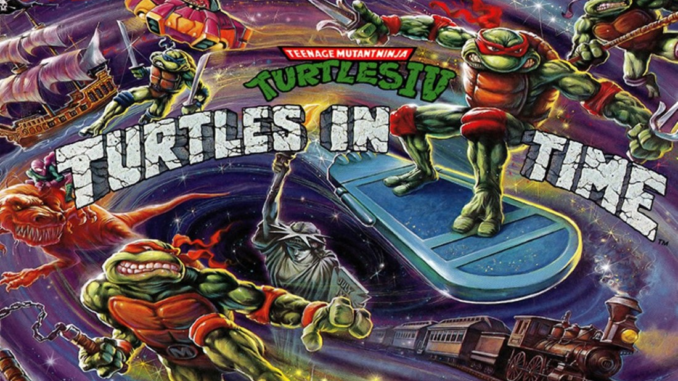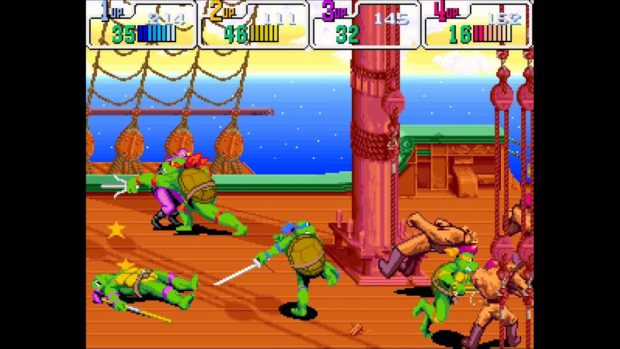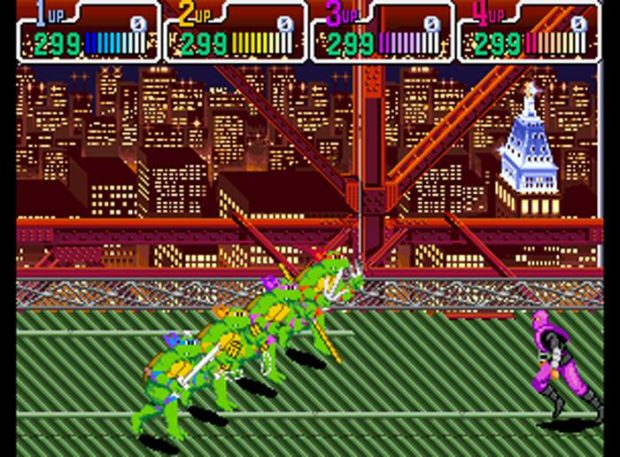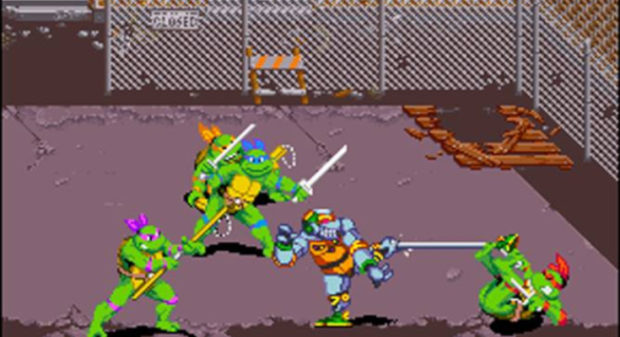
Be honest, when you were a kid, which Ninja Turtle did you want to be? Did you want to be Michaelangelo, the wild child with a passion for partying? Maybe you preferred to be the leader – calm, cool, and collected like Leonardo. If you were the tallest or oldest in your group, did you want to be Raphael or were always assigned that turtle? If you enjoyed being the brains of your group, Donatello was your guy. Whichever turtle you chose, you were sure to have a great time playing with your friends. Much like our childhood, choosing a radioactive reptile is crucial while playing 1992’s Teenage Mutant Ninja Turtles: Turtles in Time.

Turtles in Time has both arcade and Super Nintendo versions. I chose to play the SNES version for this review. (To be specific, I was playing on a modified Wii with a Gamecube controller.) For my first playthrough, the only modification made before playing was changing the difficulty setting from normal to easy. The controls were simple: jump, attack, and directionals. Combining the controls allowed for a variety of special attacks which were more challenging to master. In no time, skills like jump-kick and throwing enemies were learned and well used.
For the rest of my playthroughs, the difficulty remained on easy and the controller setting was adjusted from “Type A†to “Type Bâ€. The mapping was more efficient and easier to manage. Another key element to playing Turtles in Time is knowing your turtle’s abilities. Leonardo’s dual katanas and Donatello’s bo staff offered distance attacks. Michelangelo’s nunchucks and Raphael’s twin sai did well when crowded by enemies. Much like any other video game, memorizing boss patterns and enemy attacks is paramount to your survival. Bosses like Baxter Stockman and Metalhead were fairly simple to memorize. The Sewer Surfin’ bonus level took several plays but was easily mapped.

Ultimately, I swallowed my pride and recruited my husband to help me defeat the game. “There’s no ‘I’ in ‘TEAM’†as they say. The game functioned better with two players. Enemies spawned from both sides of the level which gave the opportunity to create a strategy. Saying things like, “Take that pizza.†or “Stay on the right.†felt like fighting beside a real turtle teammate. The later bosses had more intricate moves and there was a special appearance from my favorite TMNT bad guy – Bebop. After only two playthroughs, and a few adult beverages, we finally defeated Super Shredder. Take that, you bloated beanbag!
With a final play time of just over 30 minutes, some might say Turtles in Time is “too easyâ€. I disagree. The game offered the right amount of challenges to keep you playing without getting overwhelmed with enemies or bored by the lack of tasks. With enough practice, the game can be mastered by solo players or give a dynamic duo an upbeat challenge. Unlike the arcade, the SNES version has two alternative game play modes: Time Trial and Versus. The versus mode allows for players to test their skills against each other while the time trial can be used by a solo player in a race against themself. These two modes alone add a significant amount of replay value that is sure to be enjoyed by any Teenage Mutant Ninja Turtle fan.

For a brief comparison, I played the arcade version of Turtles in Time on MAME. Immediately I preferred the dialogue, animations, and enemies. That said, it was significantly easier to beat with limitless credits at my disposal. Defeating Shredder wasn’t nearly as satisfying but nonetheless, the job got done. Overall, I highly recommend Teenage Mutant Ninja Turtles: Turtles in Time for gamers of all skill levels, especially if you’re looking to introduce a new gamer to a timeless classic. I give this game 8 out of 10 pizza slices because I took two for myself! Cowabunga!


Great review!
Very well-written review of my favorite game. Keep up the awesome writing!